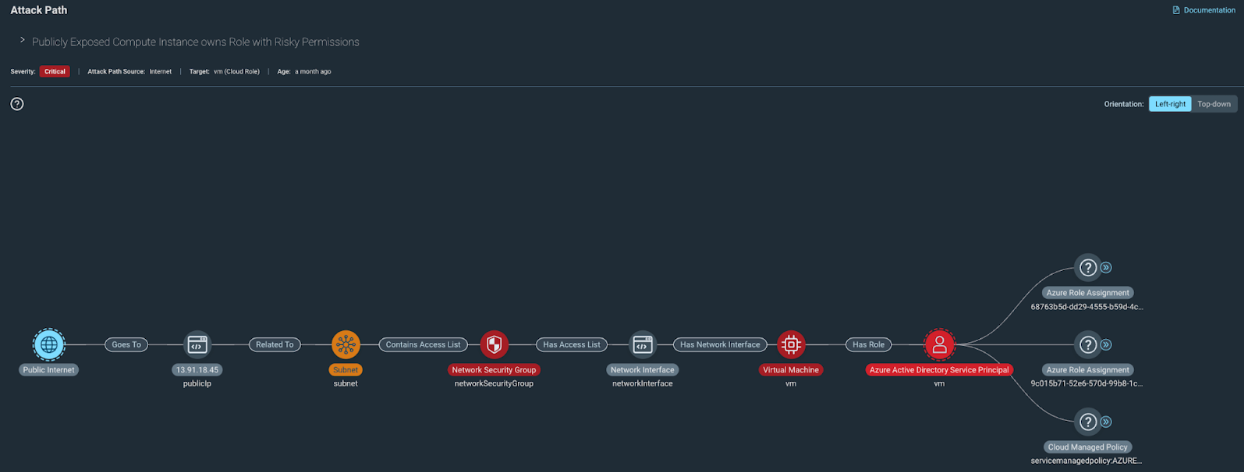Last updated at Wed, 24 Jan 2024 23:30:51 GMT
Cloud environments differ in a number of ways from more traditional on-prem environments. From the immense scale and compounding complexity to the rate of change, the cloud creates a host of challenges for security teams to navigate and grapple with. By definition, anything running in the cloud has the potential to be made publicly available, either directly or indirectly. The interconnected nature of these environments is such that when one account, resource, or service is compromised, it can be fairly easy for a bad actor to move laterally across your environment and/or grant themselves the permissions to wreak havoc. These avenues for lateral movement or privilege escalation are often referred to as attack paths.
Having a solution in place that can clearly and dynamically detect and depict these attack paths is critical to helping teams not only understand where risks exist across their environment but arguably more importantly how they are most likely to be exploited and what that means for an organization – particularly with respect to protecting high-value assets.
Detect and Remediate Attack Paths With InsightCloudSec
Attack Path Analysis in InsightCloudSec enables Rapid7 customers to see their cloud environments from the perspective of an attacker. It visualizes the various ways an attacker could gain access, move between resources, and compromise the cloud environment. Attack Paths are high fidelity signals in our risk prioritization model that focuses on identifying toxic combinations that lead to real business impact.
Since Rapid7 initially launched Attack Path Analysis, we’ve continued to roll out incremental updates to the feature, primarily in the form of expanded attack path coverage across each of the major cloud service providers (CSPs). In our most recent InsightCloudSec release (12.12.2023), we’ve continued this momentum, announcing additional attack paths as well as some exciting updates around how we visualize risk across paths and the potential blast radius should a compromised resource within an existing attack path be exploited. In this post, we’ll dive into an example of one of our recently added attack paths for Microsoft Azure along with a bit more detail about the new risk visualizations. So with that, let’s jump right in.
Expanding Coverage With New Attack Paths
First, on the coverage side of things we’ve added seven new paths in recent releases across AWS and Azure. Our AWS coverage was extended to support ECS across all of our AWS Attack Paths, and we also introduced 3 new Azure Attack paths. In the interest of brevity, we won’t cover each of them, but we do have an ever-developing list of supported attack paths you can access here on the docs page. As an example, however, let’s dive into one of the new paths we released for Azure, which identifies the presence of attack paths targeting publicly exposed instances that also have attached privileged roles.

This type of attack path is concerning for a couple of reasons: First and foremost, an attacker could use the publicly exposed instance as an inroad to your cloud environment due to the fact that it’s publicly accessible, gaining access to sensitive data on the resource itself or accessing data the resource in question has indirect access to. Secondly, since the attached role is capable of escalating privileges, an attacker could then leverage the resource to assign themselves admin permissions which could in turn be used to open up new attack vectors.
Because this could have wide-reaching ramifications should it be exploited, we’ve assigned this a critical severity. That means we’ll want to work to resolve this as fast as possible any time this path shows up across our cloud environments, maybe even automating the process of closing down public access or adjusting the resource permissions to limit the potential for lateral movement or privilege escalation. Speaking of paths with widespread impact should they be exploited, that brings me to some other exciting updates we’ve rolled out to Attack Path Analysis.
Clearly Visualizing Risk Severity and Potential Blast Radius
As I mentioned earlier, along with expanded coverage, we’ve also updated Attack Path Analysis to make it clearer for users where your riskiest assets lie across a given attack path and to clearly show the potential blast radius of an exploitation.
To make it easier to understand the overall riskiness of an attack path and where its choke points are, we’ve added a new security view that visualizes the risk of each resource along a given path. This new view makes it very easy for security teams to immediately understand which specific resources present the highest risk and where they should be focusing their remediation efforts to block potential attackers in their tracks.

In addition to this new security-focused view, we’ve also extended Attack Path Analysis to show a potential blast radius by displaying a graph-based topology map that helps clearly outline the various ways resources across your environment - and specifically within an attack path - interconnect with one another.
This topology map not only makes it easier for security teams to quickly hone in on what needs their attention first during an investigation, but also where a bad actor could move next. Additionally, this view helps security teams and leaders in communicating risk across the organization, particularly when engaging with non-technical stakeholders that find it difficult to understand why exactly a compromised resource presents a potentially larger risk to the business.
We will continue to expand on our existing Attack Path Analysis capabilities in the future, so be sure to keep an eye out for additional paths being added in the coming months as well as a continued effort to enable security teams to more quickly analyze cloud risk with the context needed to effectively detect, communicate, prioritize, and respond.
